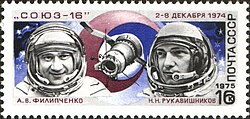Anatoly Vasilyevich Filipchenko
| Anatoly Vasilyevich Filipchenko | |
|---|---|

|
|
| Country: |
|
| Organization: | WWS |
| Call sign: | Буран (" Buran ") |
| selected on | January 10, 1963 |
| Calls: | 2 space flights |
| Start of the first space flight: |
October 12, 1969 |
| Landing of the last space flight: |
December 8th 1974 |
| Time in space: | 10d 21h 3min |
| retired on | January 1982 |
| Space flights | |
Anatoli Wassiljewitsch Filipschenko ( Russian Анатолий Васильевич Филипченко ; born February 26, 1928 in Dawydowka near Voronezh , Russian SFSR ) is a former Soviet cosmonaut .
Life
After school he learned the profession of lathe operator. He later joined the Red Army and was trained at the Chuguyev Military Aviation School (graduated with honors). From 1950 he did service as a fighter pilot in the Air Force of the USSR. In 1960 he successfully completed his correspondence course at the Air Force Military Academy “JA Gagarin” .
In January 1963 Filipchenko was selected as a cosmonaut. After completing his basic training, he was assigned to the Spiral Project in July 1965 . Here he and other cosmonauts should participate in the development of a reusable space shuttle at an early stage .
When the Soyuz spaceship, which had been developed for a long time, was ready for action, Filipchenko received training as a commander of this type. He received his first nomination as substitute commander for the Soyuz 5 flight in January 1969.
In October 1969 Filipchenko made his first space flight with Soyuz 7 . He was also in command of the senior Viktor Gorbatko , a member of the Soviet Union's first cosmonaut group . Soyuz 7 was part of a joint mission with Soyuz 6 and Soyuz 8 . Filipchenko should have docked with Soyuz 8, but this failed.
For the long-term flight from Soyuz 9 in June 1970 Filipchenko was again the substitute commander. The flight engineer Georgi Gretschko was assigned to him . Filipchenko and Grechko were then scheduled for a Soyuz flight, during which the contact coupling system was to be tested for the first time. With the death of the Soyuz 11 crew in June 1971, all further plans were put on hold.
Filipchenko went back to the Spiral project, where he replaced German Titov as head of the cosmonauts. In November 1972 he was called to the Apollo Soyuz Test Project , which was carried out in cooperation with the American space agency NASA . Filipchenko was nominated as a substitute commander for this first international joint flight. It was part of his job to carry out the test flight with a special Soyuz version.
Together with Nikolai Rukawischnikow he started on December 2, 1974 in Soyuz 16 . In the days that followed, the entire program, which was later carried out by Soyuz 19 , was simulated except for the coupling . During the Apollo Soyuz project it was available as a reserve for Alexei Leonov , but was not used.
At the time of the flight, the colonel, hero of the Soviet Union and aviation cosmonaut of the USSR was married and the father of two sons.
Filipchenko was appointed major general in 1987. In 1982 he left the active cosmonaut corps. Later he worked as a director of a design office in Kharkov . In 1987 he achieved the title of candidate in military sciences . He has been retired since 1993.
See also
Web links
- Short biography on spacefacts.de
- Anatoli Wassiljewitsch Filipschenko in the Encyclopedia Astronautica (English)
- Filipchenko on warheroes.ru (Russian)
| personal data | |
|---|---|
| SURNAME | Filipchenko, Anatoly Wassiljewitsch |
| ALTERNATIVE NAMES | Филипченко, Анатолий Васильевич (Russian) |
| BRIEF DESCRIPTION | soviet cosmonaut |
| DATE OF BIRTH | February 26, 1928 |
| PLACE OF BIRTH | Davydovka near Voronezh |
